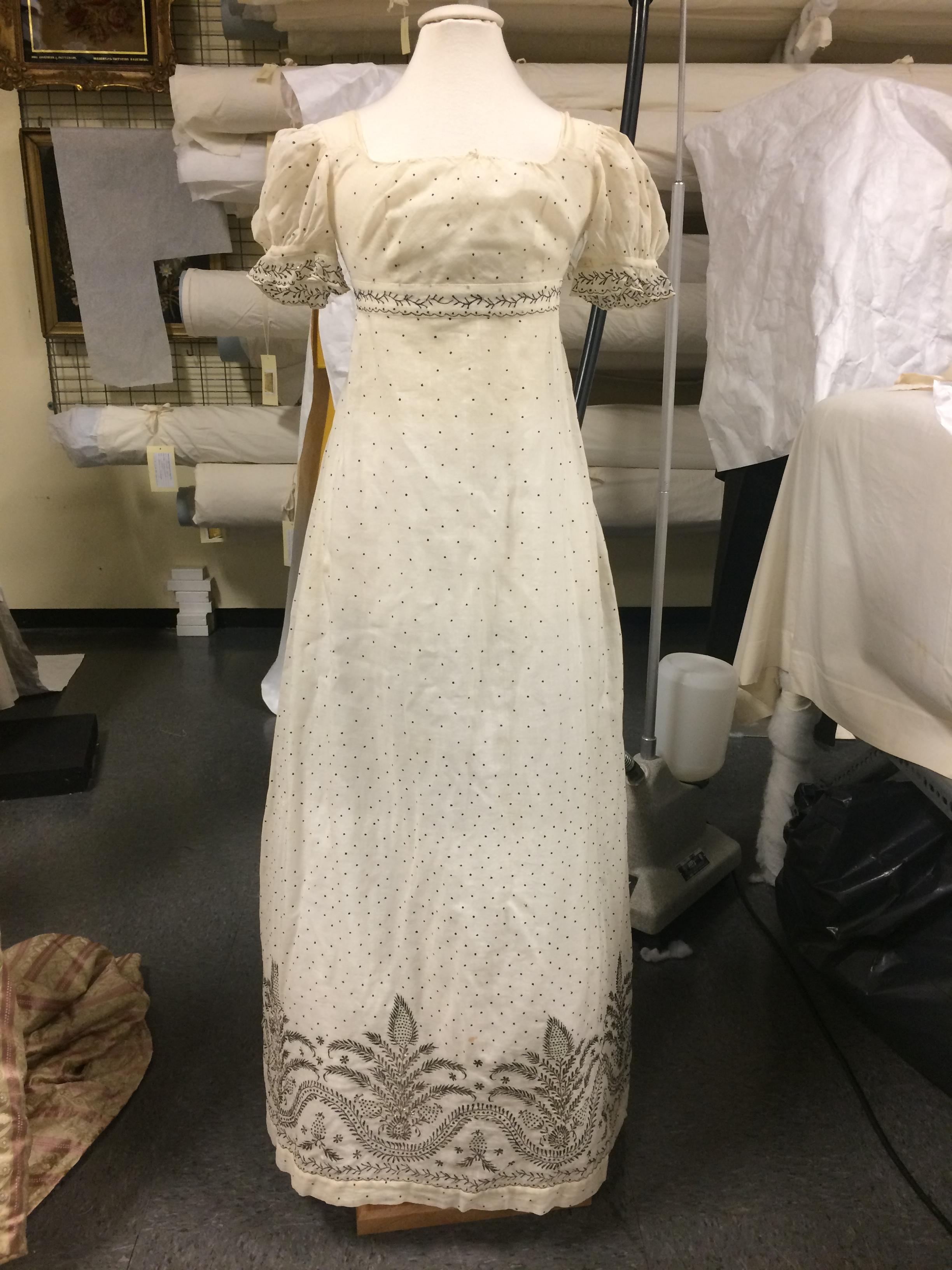All That Glitters: Regency Style and Metallic Trim
By Sarah Lindberg

Fashions from 1800-1820 (the British Regency and the American Federal period) reflected the Neoclassical movement that had begun in the previous century. As in architecture and visual arts, women’s fashion emulated ancient Greek and Roman models. Although the marble statues that inspired them were originally brightly painted, Regency dresses were typically white or in pale colors to imitate bleached stone. The Fashion Archives team recently uncovered this evening dress in a box mistakenly labeled “1820s.” The dress exemplifies Regency trends and presents interesting preservation challenges.

The dress originally belonged to Frances Billop Wyatt (1795-1863). Its high waist and low square neckline are typical of Regency fashion, while the slight flare of the skirt dates it to c. 1810-1815, when dresses began to move away from the more tubular styles of the 1800s. These styles were a dramatic departure from eighteenth-century fashion, particularly in America where fashion evolved more slowly than in Europe. The dress’ sheer cotton muslin produces a soft, revealing silhouette intended to emulate classical drapery. However, the choice of fabric was also thoroughly modern. Muslins like this were either imported from India or woven in Europe or America, possibly using the power looms invented in 1785. Fashionable women’s dress recalled the ancient past while showcasing international trade and early industrialization.

Detail of hem decoration.

The dress has an overall dot pattern, vines at the waist and cuffs, and Greek-inspired leaves at the hem. In their current state, these decorations resemble embroidery done in metal-wrapped silk thread, but they are actually made from flattened silver wire, wrapped through the fabric like staples. This was a popular decoration for European court wear. Most of the wire has tarnished, but the embellishments at the hem are still bright.
 View of tarnished dots, and holes showing location of missing wires.
View of tarnished dots, and holes showing location of missing wires.
The black tarnish is a layer of silver sulfide, which forms when silver reacts with sulfur-containing compounds. Polishing the silver would likely stain the surrounding fabric. We can prevent further tarnish by displaying the dress in low light and museum-standard 50% relative humidity.

Frances Billop was around fifteen when she wore this dress, and she likely outgrew it quickly. In its original state, the dress would have displayed her family’s wealth and access to European styles. It will be on view through August 2018 in “In Full Glory Reflected: Maryland during the War of 1812.”
XX.1.53 The Noel Wyatt Collection
Sources and Further Reading:
Colburn, Kathrin. “A Double-Headed Eagle Embroidery: Analysis and Conservation,” Metropolitan Museum Journal 41 (2006): 65-73.
Deutsch, Alexandra. A Woman of Two Worlds: Elizabeth Patterson Bonaparte. Baltimore: Maryland Historical Society, 2016.
Dress c. 1800-1804, The Metropolitan Museum of Art 2015.538
Gontar, Cybele. “Empire Style, 1800-1815.” In Heilbrunn Timeline of Art History. New York: The Metropolitan Museum of Art, 2000-. http://metmuseum.org/toah/hd/empr/hd_empr.htm (last modified October 2004)
Standing maiden with kerchief c. 300-275 BC, The Walters Museum of Art 48.296
Philadelphia Museum of Art. “Finishing Techniques in Metalwork: Hands-Free Silver ‘Polishing.’” http://www.philamuseum.org/booklets/7_44_85_1.html?page=2 (accessed August 7, 2017).
Shelley, Marjorie. The Care and Handling of Art Objects: Practices in the Metropolitan Museum of Art. New York: The Metropolitan Museum of Art, 1987.
Watt, Melinda. “Nineteenth-Century European Textile Production.” In Heilbrunn Timeline of Art History. New York: The Metropolitan Museum of Art, 2000-. http://metmuseum.org/toah/hd/txtn/hd_txtn.htm (last modified October 2004)
New Call-to-action

